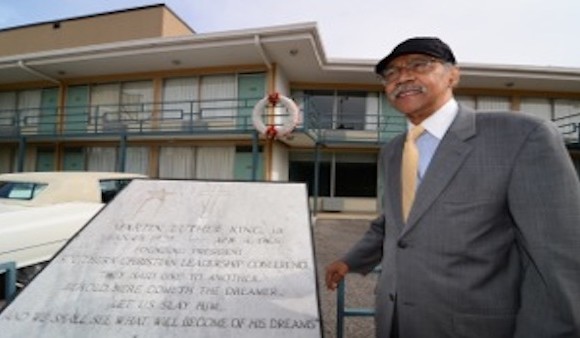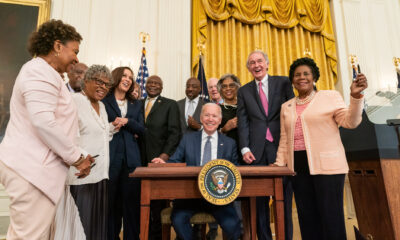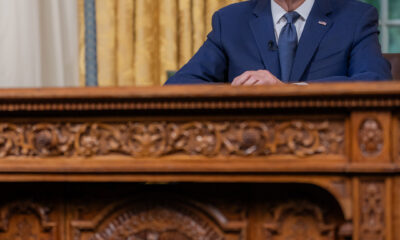Culture
Witness To A Dream: Interview with Rev. Samuel “Billy” Kyles, a Living Treasure and Witness to MLK’s Assassination

The tragic death of Dr. Martin Luther King on April 4, 1968 shook the world and rattled the burgeoning Civil Rights Movement to its core. Dr. King had come to Memphis in support of striking sanitation workers when he was felled by an assassin’s bullet on the balcony of the Lorraine Motel in Memphis, Tennessee.
Most of us have read the history books, seen films, and heard sermons about Dr. King and his message. Reverend Samuel “Billy” Kyles actually was there; one of three men in room 306 of the Lorraine Motel that fateful day (in addition to Rev. Kyles and Dr. King, the other was Rev. Ralph Abernathy, King’s friend and associate in the Southern Christian Leadership conference, who passed away in 1990).
“I was on the balcony with Martin,” said Rev. Kyles, speaking to a group of journalists recently at the National Civil Rights Museum in Memphis, constructed around the preserved site of the Lorraine Motel. The 78-year old minister is a member of the museum’s board of directors, and usually visits the site twice a week. Listening to his words, I felt chills.
“He was on the balcony, waiting to come downstairs,” said Rev. Kyles. “Waiting to come downstairs, get in the car, and go to my home for dinner. We spent the last hour, three of us – three preachers in a room for an hour.”
What did they talk about? “We talked preacher talk!” said Rev. Kyles with a smile, one of the few light moments from the conversation. “You say, how you talk preacher talk? I say, you gotta be a preacher to talk preacher talk!”
The hour was getting late. Dinner, and a rally, awaited. “I am the last of the ones, of the three, that was on the balcony and in the room, back and forth,” Rev. Kyles recalled. “And that was holding us up from going. So I said, guys, we have got to go. We have a rally tonight.”
Others arrived to accompany the group, waiting in the parking lot below while the three preachers moved between the room and the balcony. “So we were waving, and saying hello. Jesse Jackson hollered out to Martin – Jesse was on the ground – ‘Martin, it’s getting cold outside, you better get your coat.’ [Dr. King] said, ‘OK, I’ll get my coat.’”
A moment later, the fatal shot rang out. Reverend Kyles’ memories of that moment remain vivid and detailed; painful to listen to even today. “To see the hole in his face, blood was everywhere, and it was, it was incredible,” he said softly. “Just, just so much blood. The bullet’s a dum-dum; it’s called a dum-dum. As it passes through the body, it heats up and it mushrooms. So it mushroomed into his body.”
“And the necktie that he had on,” he continued. “I don’t know why I remember this, but the knot was upside down…He was lying on the balcony. And I was saying to him – we were talking to him but he couldn’t hear, it had severed his spinal cord, and everything that that bullet could do to his body.”
Amidst the confusion, an ambulance was called, but of course it was already too late.
At the hospital, “We waited, and we waited. Finally the word came. I don’t know how that happened, but it did happen…We never said he died. We never said he was killed. We said, ‘We lost him. We lost him. We lost him.’” Rev. Kyle paused thoughtfully, remembering the moment. “That’s what we said.”
And just like that, Dr. King was gone, but of course his dream has never died – delayed, perhaps, deferred, maybe, but definitely not dead.
“All the things he could have been. All the things he could have been,” Rev. Kyle repeated softly. “Yet he dies on a cold, concrete floor. In Memphis. Tennessee.” Here, Rev. Kyles’ voice rose, to a preacher’s cadence: “And they say, we will shoot this dreamer and see what happens to his dream. And the witness comes forth, and say, yes, regretfully, I can tell you, you can kill the dreamer. But no, absolutely, you cannot kill the dream. The dream is still alive.”
About the National Civil Rights Museum:
The National Civil Rights Museum, located at the Lorraine Motel, the assassination site of Dr. Martin Luther King Jr., chronicles key episodes of the American civil rights movement and the legacy of this movement to inspire participation in civil and human rights efforts globally, through our collections, exhibitions, and educational programs.
(from the museum’s Mission Statement)
National Civil Rights Museum
450 Mulberry St.
Memphis, TN 38103
Phone: (901) 521-9699
http://www.civilrightsmuseum.org
The National Civil Rights Museum at the Lorraine Motel was established in 1991 as a private, non-profit institution. It is currently undergoing a $27-million renovation and will fully reopen in January of 2014. The museum’s main building is closed during the renovation, but public access to the balcony outside room 306 will be allowed starting November 19. This is the first time the public has been allowed on the balcony since the museum opened. During renovations, the museum’s building across the street, which includes the boarding house from which James Earl Ray fired the fatal shot, will remain open.

-

 Featured10 months ago
Featured10 months agoCalifornia Is the First State to Create A Public Alert for Missing Black Youth
-

 Featured10 months ago
Featured10 months agoAfrican American Leaders Stay the Course Amid Calls for President Biden To Bow Out of Race
-

 Featured10 months ago
Featured10 months agoThe Debate Fallout Lands on Both Candidates
-

 Featured9 months ago
Featured9 months agoPresident Joe Biden Decides to Withdraw from the Presidential Race
-

 Featured10 months ago
Featured10 months agoPresident Joe Biden Describes Shooting of Donald Trump As ‘Sick’
-

 Featured9 months ago
Featured9 months agoIn One of His Final Speeches as President, Biden Says It’s Time for ‘Fresh Voices’

